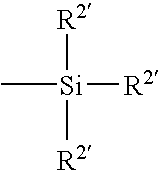Packaging solutions
a technology for ophthalmic devices and packaging solutions, applied in the direction of packaging sterilisation, transportation and packaging, rigid containers, etc., can solve the problems of reducing shelf life and/or adverse reactions, limited use of surfactants in packaging solutions, and many people wearing contact lenses still experience dryness or eye irritation, etc., to achieve uniform coating of anionic polymer, preserve the sterility of solution and ophthalmic devi
- Summary
- Abstract
- Description
- Claims
- Application Information
AI Technical Summary
Benefits of technology
Problems solved by technology
Method used
Image
Examples
example 1
[0070]A clean hilafilcon A lens, which is a copolymer composed mainly of HEMA and NVP, was soaked in a lens packaging solution within the scope of the present invention overnight and autoclaved for 30 minutes at 121° C. The ingredients and amounts of the solution are set forth in Table 2. The carboxymethylcellulose was a medium viscosity (MV) grade (viscosity no greater than 30 cp). The XPS results for the lens are set forth below in Table 4.
TABLE 2Ingredients% w / wSodium borate0.215Boric acid1.000Ethylenediaminetetraacetic0.050acid (EDTA)Carboxymethylcellulose1.000(MV)Glycerin1.000pH = 7.16Osmolality = 347 mOsm / kg
PUM
| Property | Measurement | Unit |
|---|---|---|
| osmolality | aaaaa | aaaaa |
| pH | aaaaa | aaaaa |
| concentration | aaaaa | aaaaa |
Abstract
Description
Claims
Application Information
 Login to View More
Login to View More - R&D
- Intellectual Property
- Life Sciences
- Materials
- Tech Scout
- Unparalleled Data Quality
- Higher Quality Content
- 60% Fewer Hallucinations
Browse by: Latest US Patents, China's latest patents, Technical Efficacy Thesaurus, Application Domain, Technology Topic, Popular Technical Reports.
© 2025 PatSnap. All rights reserved.Legal|Privacy policy|Modern Slavery Act Transparency Statement|Sitemap|About US| Contact US: help@patsnap.com



